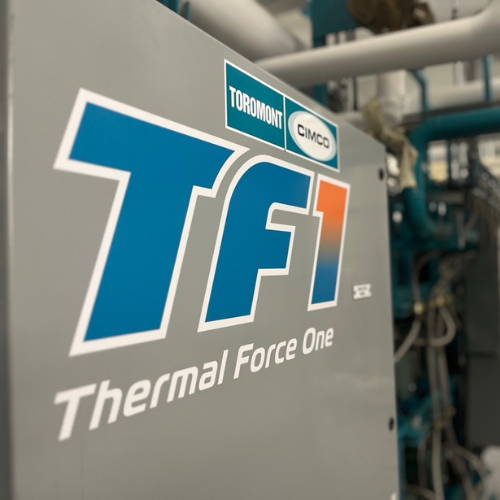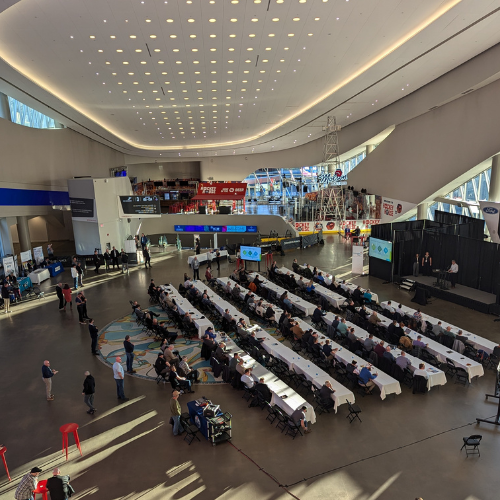The Canada Games Complex (CGC) is being renovated to become the first home for women’s hockey in Canada. Cape Breton University (CBU) and the Blizzards Minor Hockey Association are reopening the facility, which will also feature Cape Breton Island’s first accessible sledge hockey rink. The project includes an NHL-sized ice surface, a new energy-efficient refrigeration system, and an all-electric heating and cooling system. The upgraded CGC will host community events, a health center, an indoor walking track, and a fitness facility, all while aligning with CBU’s sustainability goals.
The Canada Games Complex (CGC) was originally constructed for the Jeux Canada Winter Games in 1987 and served the local Cape Breton community for more than 35 years before aging equipment and costly maintenance forced the facility to become dormant. By now, the refrigeration system was outdated and inefficient, and the two existing oil-fired boilers and the Zamboni were also on their last legs.
Meanwhile, the local Blizzards Minor Hockey Association (a girls minor hockey organization) was growing rapidly but had no home rink for its 400+ players. Because of grandfathered time slots and the priority given to existing leagues, the new female association had no access to prime-time ice times and had to make do with leftover slots.
The CGC had no tenant, and the Blizzards had no home. So, representatives from Cape Breton University (CBU) and the Blizzards joined forces to come up with a plan to reopen the CGC’s doors and create the first-ever home for Women’s Hockey in Canada. The venue will be shared between the university’s women’s hockey team (the CBU CAPERS) and the Blizzards.
The community and country unanimously voted in favor of the project when Sydney won the national Kraft Hockeyville competition, and the renovation subsequently received the green light. The 90,000 ft2 project kicked off in May 2023 with completion scheduled for December 2024.
The upgrade includes a full retrofit of the former international-sized arena to an NHL-sized ice surface (200 ft x 85 ft), which is being raised to be accessible for sledge hockey as well. The 1,744-seater arena will be supported by a brand-new energy-efficient refrigeration plant with full heat recovery capabilities, designed and installed by CIMCO. The recovered heat will be transferred to an all-electric heating and cooling system that will facilitate the retirement of the age oil-fired boilers.
The project is a crucial component of the university's $200 million Forever CBU capital campaign, which aims to modernize the campus and enhance sports and recreation facilities.
.png?sfvrsn=3861d922_0)
Community Matters
“Our university has always been built by the community for the community. That’s why it was important for us that the facility serves the community as well, not just the students”
- Steve Horne
Once complete, the CGC will have the first accessible sledge hockey facility on Cape Breton Island, and CBU hopes that this will usher in a new era for the game. With the upgraded facility, they want to grow the game and also host both local and international games in the future.
The renovated CGC will be so much more than just an ice arena though. It will also be used to host a myriad of other events – both for the university as well as the greater community. A new health center is also being included to make healthcare services accessible to the entire student body. The community can also look forward to a new indoor walking track and a fitness facility for more than 7,000 users.
“Our university has always been built by the community for the community. That’s why it was important for us that the facility serves the community as well, not just the students,” explains Steve Horne, Development Manager – Recreation, Sport and Special Projects, CBU.
Technology and Equipment
CIMCO installed a 120 TR (422 kW) ECO CHILL ice rink refrigeration system to serve the ice rink, complete with heat recovery to repurpose the waste heat from the cooling process. The waste heat is boosted via heat pumps to be used for the facility’s heating requirements, replacing the end-of-life boilers.
The design is based on a CIMCO low-charge Ammonia/ Calcium Chloride/ Glycol recirculation system using polyethylene rink piping in the floor grids with a duplex plate and frame condenser. It includes CIMCO’s IQ control system that maximizes savings by ensuring that the recovered heat is used effectively throughout the building.
The main objective of the control system is to reuse as much as possible of the heat reclaimed and prevent the usage of additional heat if not absolutely necessary. Based on initial calculations, the arena’s new thermal plant is expected to achieve energy savings of 64–84% of the total heat rejection from the refrigeration system. The heat rejected by the refrigeration system will be used for the facility’s various heating requirements, including:
- Preheating and heating of domestic water;
- Snow melting;
- Underfloor rink heating – frost protection;
- Hot water pre-heating to 95° F; and
- Dehumidification.
.png?sfvrsn=e661d922_0)
Sustainability is Key
"Moving to sustainable technology was a conscious decision"
- Adam Smith
“Moving to sustainable technology was a conscious decision,” explains Adam Smith, Engineer at CBU. CBU leveraged its relationship with The Verschuren Centre to develop a Zero-Carbon Plan for the university. This center, which is committed to accelerating pathways toward sustainability, collaborated with CBU to devise this plan, and the CGC Expansion & Renovation was the ideal opportunity to implement it.
Sustainability was top of mind when it came to equipment choice, according to Smith. In addition to the new efficient refrigeration system complete with heat recovery, CBU was focused on implementing a new all-electric, highly efficient HVAC plant.
The mechanical plant will consist of a low-temperature (85°F) heating loop and a high-temperature heating loop (170°F) for general space heating. The low-temperature loop will be served by a 160 TR air-source heat pump and is a perfect sink for the waste heat from the refrigeration plant.
A 120 TR water-to-water heat pump will raise the temperature from the low-temperature loop to serve the high-temperature loop. The proposed heating system will be a complete backup staged electric boilers on both loops. This proposed heating system will completely electrify the thermal system for the Canada Games Complex, preparing the facility for further GHG reduction as the Nova Scotia grid continues to become cleaner in the future.
The ventilation system will consist of a modern dehumidification unit and auxiliary air handling units (AHUs). This modern ventilation system will facilitate energy recovery on all exhaust air systems, where previously there was none.
Lastly, the Canada Games Complex will see a complete renovation of the lighting system as much of the facility maintains the original lighting. The new lighting system will be a complete conversion to LED fixtures equipped with a sophisticated lighting control system. All of the equipment inside the facility will also be electrified. CBU has purchased an all-electric Zamboni and an all-electric forklift.
CBU implemented renewable energy through the Solar for Community Buildings Program. At the time of installation, the new solar installation was the largest solar power installation on Cape Breton Island, with 500 solar panels (150 kW) on the roof of the CGC. Excess energy is exported to Nova Scotia Power. This installation offsets greenhouse gas (GHG) emissions equivalent to 25 gasoline-powered passenger vehicles every year.
Using a natural refrigerant like ammonia (R717) ties in perfectly with CBU’s sustainability goals as this is the most environmentally friendly refrigerant with a Global Warming Potential (GWP) and Ozone Depleting Potential (GWP) of 0. This cuts direct (Scope 1) emissions to 0. Thanks to ammonia’s favorable thermodynamic properties and proven efficiency in arena applications, indirect (Scope 2) emissions are also lowered, more so by the addition of heat recovery.
Plus, ammonia is easily available at a steady price with no risk of suffering under the global refrigerant phase-out/down of fluorinated refrigerants (f-gases) – giving CBU the peace of mind that the facility is future-ready.
As part of the project, CBU is creating two electric vehicle charging stations.
CBU has a Climate Action Commitment plan that is in line with provincial, national, and global initiatives. The university aims to meet (or exceed) the Scope 1 and Scope 2 GHG emissions reductions established in the Nova Scotia Environmental Goals and Climate Change Reduction Act, which includes a 53% GHG emissions reduction by 2030 and net zero by 2050.
The university is currently in the beginning stages of enacting their comprehensive decarbonization plan and they’re investigating different ways to harness waste heat and share it between facilities.
CBU is undergoing a transformational capital development plan that will include a new academic building and the addition of a new medical campus in the heart of its campus. CBU is assessing the opportunities to interconnect these buildings with the CGC to establish an ambient loop to better utilize and share waste heat as it becomes available.
“I am immensely proud to have been involved in this long-term project from its inception,” said Drew Watson, Recreational Projects, CIMCO. “CBU has demonstrated a strong commitment to sustainable planning, undertaking extensive research to ensure that their developments will stand the test of time in the most environmentally friendly way possible.”
Related Posts

Guysborough Municipality Raises the Bar With All-in-One CO2 Heating, Refrigeration & AC

Sold-Out IRMA Innovation Day Showcases Next-Gen Ice Arena Technologies
.png?sfvrsn=ad12d922_1)
The Business Case for Replacing Your Refrigerant System
STAY UP TO DATE
Get the latest industry insights and important updates delivered right to your inbox.
|
|

2b98b3179cf96a7ea8b6ff0100a9fc4b.png?sfvrsn=4861d922_0)

